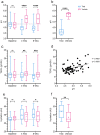Maintenance of an Acidic Skin Surface with a Novel Zinc Lactobionate Emollient Preparation Improves Skin Barrier Function in Patients with Atopic Dermatitis
- PMID: 38175365
- PMCID: PMC10891035
- DOI: 10.1007/s13555-023-01084-x
Maintenance of an Acidic Skin Surface with a Novel Zinc Lactobionate Emollient Preparation Improves Skin Barrier Function in Patients with Atopic Dermatitis
Abstract
Introduction: The skin of patients with atopic dermatitis (AD) is characterised by elevated pH. As a central homeostatic regulator, an increased pH accelerates desquamation and suppresses lipid processing, resulting in diminished skin barrier function. The aim of this study was to determine whether a novel zinc lactobionate emollient cream can strengthen the skin barrier by lowering skin surface pH.
Methods: A double-blind, forearm-controlled cohort study was undertaken in patients with AD. Participants applied the test cream to one forearm and a vehicle cream to the other (randomised allocation) twice daily for 56 days. Skin surface pH and barrier function (primary outcomes) were assessed at baseline and after 28 days and 56 days of treatment, amongst other tests.
Results: A total of 23 adults with AD completed the study. During and after treatment, a sustained difference in skin surface pH was observed between areas treated with the test cream and vehicle (4.50 ± 0.38 versus 5.25 ± 0.54, respectively, p < 0.0001). This was associated with significantly reduced transepidermal water loss (TEWL) on the test cream treated areas compared with control (9.71 ± 2.47 versus 11.20 ± 3.62 g/m2/h, p = 0.0005). Improvements in skin barrier integrity, skin sensitivity to sodium lauryl sulphate, skin hydration, and chymotrypsin-like protease activity were all observed at sites treated with the test cream compared with the control.
Conclusion: Maintenance of an acidic skin surface pH and delivery of physiologic lipids are beneficial for skin health and may help improve AD control by reducing sensitivity to irritants and allergens.
Keywords: Acid mantle; Atopic dermatitis; Eczema; Emollient; Protease; Skin barrier; pH.
© 2024. The Author(s).
Conflict of interest statement
Simon G Danby, has received fees for giving lectures and/or attending advisory boards and research funding from Almirall, Astellas Pharma, Bayer Dermatology, Hyphens, Leo Pharma, L’Oreal, MSD, Pfizer, Rohto Pharma, Sanofi and Stiefel-GSK. Michael J Cork, has been/is a Clinical Trial Investigator for the following organisations: Atopix, Galapagos, Hyphens, Johnson & Johnson, Kymab, Leo, L’Oreal/La Roche Possay, Novartis, Pfizer, Regeneron, and Sanofi-Genzyme. He is an Advisory Board member, Consultant &/or invited lecturer for the following organisations: Abbvie, Amlar, Astellas, Atopix, Boots, Dermavant, Galapagos, Galderma, Hyphens, Johnson & Johnson, Kymab, Leo, L’Oreal/La Roche Possay, Menlo, Novartis, Oxagen, Pfizer, Procter & Gamble, Reckitt Benckiser, Regeneron, Sanofi-Genzyme. Paul V Andrew, Abigail Pinnock, Anna Poyner, Κirsty Βrown, John Chittock, Linda J K Kay declare that they have no competing interests.
Figures




References
-
- Hachem JP, Man MQ, Crumrine D, Uchida Y, Brown BE, Rogiers V, Roseeuw D, Feingold KR, Elias PM. Sustained serine proteases activity by prolonged increase in pH leads to degradation of lipid processing enzymes and profound alterations of barrier function and stratum corneum integrity. J Invest Dermatol. 2005;125(3):510–520. doi: 10.1111/j.0022-202X.2005.23838.x. - DOI - PubMed
-
- Hachem JP, Roelandt T, Schürer N, Pu X, Fluhr J, Giddelo C, Man MQ, Crumrine D, Roseeuw D, Feingold KR, Mauro T, Elias PM. Acute acidification of stratum corneum membrane domains using polyhydroxyl acids improves lipid processing and inhibits degradation of corneodesmosomes. J Invest Dermatol. 2010;130(2):500–510. doi: 10.1038/jid.2009.249. - DOI - PMC - PubMed
LinkOut - more resources
Full Text Sources
Research Materials

